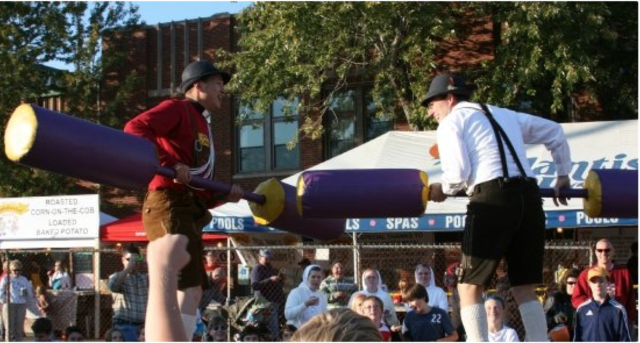 ALTON - German ancestry remains prevalent in Illinois, as it has for a century and a half. The strength of German-Americans helped shape state history through a Civil War, as well as two world wars against the old country.
ALTON - German ancestry remains prevalent in Illinois, as it has for a century and a half. The strength of German-Americans helped shape state history through a Civil War, as well as two world wars against the old country.
Each year at the St. Mary's Catholic Church Oktoberfest, the German heritage is celebrated.
Get The Latest News!
Don't miss our top stories and need-to-know news everyday in your inbox.
In the Alton area, German is, by far, the leading ethnicity. According to the 2010 census, 32.7 percent of Madison County residents report German ancestry, more than twice the next-most common ancestry, Irish, with 14.9 percent. English is third at 10.5 percent.
Some 23.8 percent of Alton residents are of German descent, while in Edwardsville, the number of German-Americans is even greater, at 36.4 percent. Similar totals are found in Bethalto (32.7 percent), East Alton (31.2), Wood River (27.8), and Granite City (23.4)
There are plenty of Germans elsewhere in the area, particularly in Calhoun and Jersey counties, where 46.2 and 42.8 percent of the population, respectively, comes from German descent. Macoupin County is 35.8 percent German, while Greene County is 30.7 percent.
The current numbers reflect the state’s history. Of the nearly 1.8 million residents of Illinois in 1860, nearly 325,000 were of foreign birth. Germans were the largest ethnic group with 130,000, nearly eight percent of the state’s total population. Twenty percent of the Chicago population was German. Many had arrived following the failed German revolution of 1848.
A heavy concentration of Germans was also found in St. Clair County, near Belleville. Others settled in cities like Quincy, Peoria, Springfield, and Galena. In the northern Illinois community of Peru, Germans made up 1,000 of the total population of 3,500 in 1854.
The names of a number of towns and villages across the state honor German heritage, including the Calhoun County villages of Meppen and Hamburg. Other German-influenced locales in Illinois include New Baden, New Minden, Germantown, Darmstadt, and Dresden.
*****
Many Germans were farmers, while others were laborers, merchants, and skilled tradesmen. Some followed the popular crafts of their homeland and worked as butchers, bakers, shoemakers, furniture and wagon builders, and cigar makers. Architecture of traditionally German-American buildings, often in brick, is still visible across the state.
German-language newspapers were found across the state, even in the smallest cities. In 1859, future Presidential candidate Abraham Lincoln bought the press and type to establish a German-language Republican paper. In Peoria, future Illinois Secretary of State Edward Rummel, a native of Baden, Germany, ran a German paper and print shop, which produced goods in both German and English.
John Wood, who founded the city of Quincy and served as Illinois governor for ten months in 1860-61, was born to a German mother. In 1892, John Altgeld, a Prussian native, won election for one term as Illinois governor and is best known for his pardon of three of the accused in the infamous Haymarket Riot.
Politically, German support was crucial, and their weight was felt at the first Illinois Republican state convention in 1856. The German influence was also a key factor in the 1860 presidential race, and at the Republican National Convention in Chicago, German resolutions were even incorporated into the national platform. Germans were perceived to be staunch abolitionists, though some scholars dispute that claim.
Nearly 6,000 Illinois Germans enlisted in the first six months of the Civil War, comprising practically three whole regiments. One top German commander was Friedrich Hecker, a renowned 1848 revolutionary who was a gentleman farmer near Belleville, in the heart of heavily German settlements.
Another German regimental commander from St. Clair County was Gustave Koerner, who served as lieutenant governor of Illinois from 1852-56 and was a pallbearer at Lincoln’s Springfield funeral.
By 1910, over 319,000 German immigrants were in Illinois, and over a million people of German descent – a tenth of the national total – called the state home. With nearly 400,000 first- and second-generation German immigrants, Chicago was the sixth-largest German city on the globe in 1914.
The high concentration of Germans caused some protest at the outbreak of World War I, as many of German descent decried their adopted country’s stance against their homeland. Music by German composers such as Mozart and Beethoven was banned in some public places, and some German-Americans were under surveillance by state and federal officials.
Other German-Americans were forced to recite loyalty oaths in public spectacles. Within a few years, use of the German language, once prominent, faded from schools and churches.
As a result, many Germans in Illinois distanced themselves from their heritage. From 1914 to 1920, the number of Illinois residents who identified themselves as German on the census dropped over 41 percent, to 112,000. But many Germans remained loyal to the American cause, and took active roles in the war effort both at home and abroad.
A quarter-century later, dislike of German residents was a minor issue in World War II, as many chose to focus their disgust on Adolph Hitler, rather than their German neighbors.
Today, German heritage in Illinois is celebrated in festivals and carnivals statewide, while some communities in Chicagoland, as well as Alton, Belleville, Moline, Peoria, Gibson City, Mascoutah, Waterloo, and Millstadt, feature popular German restaurants.
Museums and research centers on German-American history and heritage are found in several large metro areas, such as Chicago and the Quad Cities.
Tom Emery is a freelance writer and historical researcher from Carlinville, Ill. He may be reached at 217-710-8392 or ilcivilwar@yahoo.com.
More like this:
